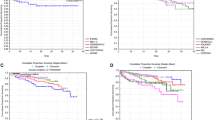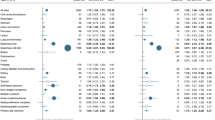Abstract
The risk of subsequent second malignant neoplasm was studied in a cohort of 634 patients, treated for a childhood cancer at the Gustave Roussy Institute between 1942 and 1969, and in complete remission five years after diagnosis. The most frequent types of first primary cancers (FPC) were Wilms' tumours (28% of the children), neuroblastomas (16%), lymphomas (12%) and soft tissue sarcomas (11%). Median follow-up duration after FPC was 19 years. Thirty-two patients (obs = 32) developed a total of 35 second cancers. Bone, thyroid, connective tissues and skin were the most frequent types of second cancer, with six patients for each type. The average annual incidence of second cancer was 0.36%. The average annual incidence for the periods 5-9, 10-14, 15-19, 20-24 and 25+ years after FPC was respectively 0.16%, 0.34%, 0.36%, 0.71% and 1.18%. The cumulative incidence of second cancer for the periods 5-20, 5-25 and 5-30 years after FPC was, respectively, 4.3% (95% CI: 2.8-6.6%), 7.8% (95% CI: 5.1-11.8%) and 13.0% (95% CI: 8.2-20.0%). The expected number of cancers in the cohort, computed from Danish cancer incidence data, was exp = 2.2. When compared to this expected number, the average annual excess incidence of second cancer, defined as obs-exp divided by the number of person years of observation, was 0.33%. This rose from 0.15% for the period 5-9 years after FPC to 1.09% for the period beginning 25 years after FPC. The standardised incidence ratio of second cancer (i.e. obs/exp) was 15 (95% CI: 10-21), and was fairly constant in the period extending from 15 to 20 years after FPC diagnosis. Obs/exp was equal to 25 for the patients who had had chemotherapy and equal to 9 for those who had not. Cyclophosphamide seemed less carcinogenic than the other alkylating agents. Obs/exp was similar for the patients who had received radiotherapy and for those who had not. The risk of cancer increased with age in the reference population and increased faster in the cohort, because the standardised incidence ratio is constant over a long period.
This is a preview of subscription content, access via your institution
Access options
Subscribe to this journal
Receive 24 print issues and online access
$259.00 per year
only $10.79 per issue
Buy this article
- Purchase on Springer Link
- Instant access to full article PDF
Prices may be subject to local taxes which are calculated during checkout
Similar content being viewed by others
Author information
Authors and Affiliations
Rights and permissions
About this article
Cite this article
de Vathaire, F., Schweisguth, O., Rodary, C. et al. Long-term risk of second malignant neoplasm after a cancer in childhood. Br J Cancer 59, 448–452 (1989). https://doi.org/10.1038/bjc.1989.92
Issue Date:
DOI: https://doi.org/10.1038/bjc.1989.92
This article is cited by
-
Die Schilddrüse nach Stammzelltransplantation im Kindes- und Jugendalter
Monatsschrift Kinderheilkunde (2007)
-
Second malignancy after treatment of childhood acute myeloid leukemia
Leukemia (2001)
-
Central neuronal tumors in childhood: relationship to dysplasia
Journal of Neuro-Oncology (1995)



